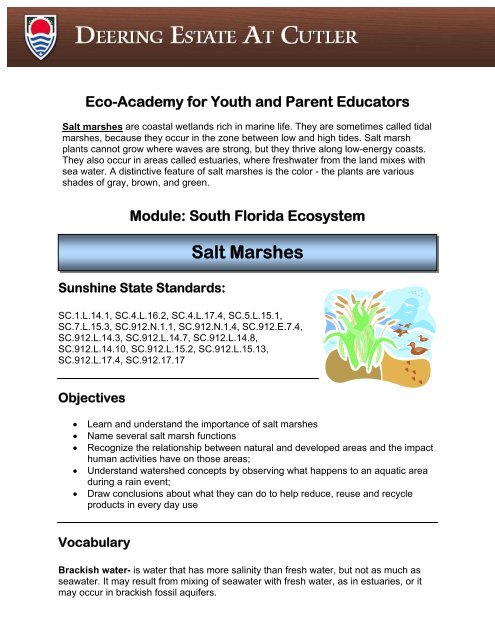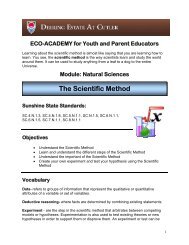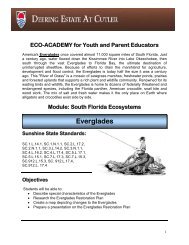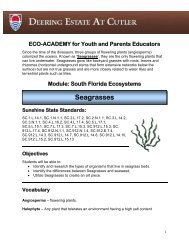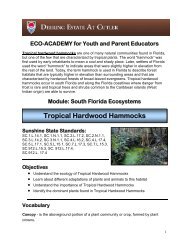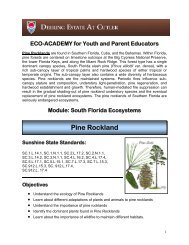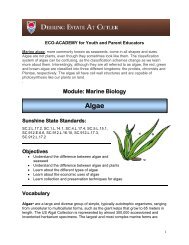Salt Marshes Lesson Plan - Deering Estate at Cutler
Salt Marshes Lesson Plan - Deering Estate at Cutler
Salt Marshes Lesson Plan - Deering Estate at Cutler
You also want an ePaper? Increase the reach of your titles
YUMPU automatically turns print PDFs into web optimized ePapers that Google loves.
Eco-Academy for Youth and Parent Educ<strong>at</strong>ors<br />
<strong>Salt</strong> marshes are coastal wetlands rich in marine life. They are sometimes called tidal<br />
marshes, because they occur in the zone between low and high tides. <strong>Salt</strong> marsh<br />
plants cannot grow where waves are strong, but they thrive along low-energy coasts.<br />
They also occur in areas called estuaries, where freshw<strong>at</strong>er from the land mixes with<br />
sea w<strong>at</strong>er. A distinctive fe<strong>at</strong>ure of salt marshes is the color - the plants are various<br />
shades of gray, brown, and green.<br />
Module: South Florida Ecosystem<br />
Sunshine St<strong>at</strong>e Standards:<br />
SC.1.L.14.1, SC.4.L.16.2, SC.4.L.17.4, SC.5.L.15.1,<br />
SC.7.L.15.3, SC.912.N.1.1, SC.912.N.1.4, SC.912.E.7.4,<br />
SC.912.L.14.3, SC.912.L.14.7, SC.912.L.14.8,<br />
SC.912.L.14.10, SC.912.L.15.2, SC.912.L.15.13,<br />
SC.912.L.17.4, SC.912.17.17<br />
Objectives<br />
• Learn and understand the importance of salt marshes<br />
• Name several salt marsh functions<br />
• Recognize the rel<strong>at</strong>ionship between n<strong>at</strong>ural and developed areas and the impact<br />
human activities have on those areas;<br />
• Understand w<strong>at</strong>ershed concepts by observing wh<strong>at</strong> happens to an aqu<strong>at</strong>ic area<br />
during a rain event;<br />
• Draw conclusions about wh<strong>at</strong> they can do to help reduce, reuse and recycle<br />
products in every day use<br />
Vocabulary<br />
<strong>Salt</strong> <strong>Marshes</strong><br />
Brackish w<strong>at</strong>er- is w<strong>at</strong>er th<strong>at</strong> has more salinity than fresh w<strong>at</strong>er, but not as much as<br />
seaw<strong>at</strong>er. It may result from mixing of seaw<strong>at</strong>er with fresh w<strong>at</strong>er, as in estuaries, or it<br />
may occur in brackish fossil aquifers.
Coast- is defined as where the land meets the sea. A precise line th<strong>at</strong> can be called a<br />
coastline cannot be determined due to the dynamic n<strong>at</strong>ure of tides. The term "coastal<br />
zone" can be used instead, which is a sp<strong>at</strong>ial zone where interaction of the sea and<br />
land processes occurs<br />
Halophyte- is a plant th<strong>at</strong> n<strong>at</strong>urally grows where it is affected by salinity in the root area<br />
or by salt spray, such as in saline semi-deserts, mangrove swamps, marshes and<br />
sloughs, and seashores.<br />
Intertidal zone- (also known as the foreshore and seashore and sometimes referred to<br />
as the littoral zone) is the area th<strong>at</strong> is exposed to the air <strong>at</strong> low tide and underw<strong>at</strong>er <strong>at</strong><br />
high tide (for example, the area between tide marks).<br />
Marsh - is a type of wetland th<strong>at</strong> is subject to frequent or continuous flood. Typically the<br />
w<strong>at</strong>er is shallow and fe<strong>at</strong>ures grasses, rushes, reeds, typhas, sedges, and other<br />
herbaceous plants. Woody plants will be low-growing shrubs. A marsh is different from<br />
a swamp, which has a gre<strong>at</strong>er proportion of open w<strong>at</strong>er surface and may be deeper<br />
than a marsh. In North America, the term "swamp" is used for wetland domin<strong>at</strong>ed by<br />
trees r<strong>at</strong>her than grasses and low herbs.<br />
Background<br />
A salt marsh is an<br />
environment in the upper<br />
coastal intertidal zone<br />
between land and salty or<br />
brackish w<strong>at</strong>er, domin<strong>at</strong>ed<br />
by dense stands of<br />
halophytic (salt-tolerant)<br />
plants such as herbs,<br />
grasses, or low shrubs.<br />
These plants are terrestrial<br />
in origin and are essential to<br />
the stability of the salt marsh<br />
in trapping and binding<br />
sediments. <strong>Salt</strong> marshes<br />
play a large role in the aqu<strong>at</strong>ic food web and the exporting of nutrients to coastal w<strong>at</strong>ers.<br />
They also provide support to terrestrial animals such as migr<strong>at</strong>ing birds as well as<br />
providing coastal protection.
Loc<strong>at</strong>ion<br />
<strong>Salt</strong> marshes occur on low-energy coasts in temper<strong>at</strong>e and high-l<strong>at</strong>itudes. These<br />
typically include sheltered environments such as embankments, estuaries and the<br />
leeward side of barrier islands and spits. In the tropics and sub-tropics they are replaced<br />
by mangroves; an area th<strong>at</strong> differs to a salt marsh in th<strong>at</strong> instead of herbaceous plants,<br />
they are domin<strong>at</strong>ed by salt-tolerant trees. Most salt marshes have a low topography<br />
with low elev<strong>at</strong>ions but a vast wide area, making them hugely popular for human<br />
popul<strong>at</strong>ions.<br />
<strong>Salt</strong> marshes are loc<strong>at</strong>ed among different landforms based on their physical and<br />
geomorphological settings. Such marsh landforms include deltaic marshes, estuarine,<br />
back-barrier, open coast, embayments and drowned-valley marshes. Deltaic marshes<br />
are associ<strong>at</strong>ed with large rivers where many occur in Southern Europe such as the<br />
Camargue in the Rhone delta or the Ebro delta. They are also highly extensive within<br />
the rivers of the Mississippi Delta. In New Zealand, most salt marshes occur <strong>at</strong> the head<br />
of estuariesin areas where there is little wave action and high sediment<strong>at</strong>ion. Such<br />
marshes are loc<strong>at</strong>ed in Awhitu Regional Park in Auckland, the Manaw<strong>at</strong>u Estuary and
the Avon-He<strong>at</strong>hcote Estuary in Christchurch. Back-barrier marshes are sensitive to the<br />
reshaping of barriers in the landward side of which they have been formed. They are<br />
common along much of the eastern coast of the United St<strong>at</strong>es and the Frisian Islands.<br />
Large, shallow coastal embayments can hold salt marshes with examples including<br />
Morecambe Bay and Portsmouth in Britain and the Bay of Fundy in North America.<br />
Tidal flooding and veget<strong>at</strong>ion zon<strong>at</strong>ion<br />
Coastal salt marshes can be distinguished from terrestrial habit<strong>at</strong>s by the daily tidal flow<br />
th<strong>at</strong> occurs and continuously floods the area. It is an important process in delivering<br />
sediments, nutrients and plant w<strong>at</strong>er supply to the marsh. At higher elev<strong>at</strong>ions in the<br />
upper marsh zone, there is much less tidal inflow, resulting in lower salinity levels. Soil<br />
salinity in the lower marsh zone is fairly constant due to everyday annual tidal flow.<br />
However, in the upper marsh, variability in salinity is shown as a result of less frequent<br />
flooding and clim<strong>at</strong>e vari<strong>at</strong>ions. Rainfall can reduce salinity and evapotranspir<strong>at</strong>ion can<br />
increase levels during dry periods. As a result, there are microhabit<strong>at</strong>s popul<strong>at</strong>ed by<br />
different species of flora and fauna dependant on their physiological abilities. The flora<br />
of a salt marsh is differenti<strong>at</strong>ed into levels according to the plants' individual tolerance of<br />
salinity and w<strong>at</strong>er table levels. Veget<strong>at</strong>ion found <strong>at</strong> the w<strong>at</strong>er must be able to survive<br />
high salt concentr<strong>at</strong>ions, periodical submersion, and a certain amount of w<strong>at</strong>er<br />
movement, while plants further inland in the marsh can sometimes experience dry, lownutrient<br />
conditions. It has been found th<strong>at</strong> the upper marsh zones limit species through<br />
competition and the lack of habit<strong>at</strong> protection, while lower marsh zones are determined<br />
through the ability of plants to toler<strong>at</strong>e physiological stresses such as salinity, w<strong>at</strong>er<br />
submergence and low oxygen levels.
The New England salt marsh is subject to strong tidal influences and shows distinct<br />
p<strong>at</strong>terns of zon<strong>at</strong>ion. In low marsh areas with high tidal flooding, a monoculture of the<br />
smooth cordgrass, Spartina alterniflora domin<strong>at</strong>e, then heading landwards, zones of the<br />
salt hay, Spartina p<strong>at</strong>ens, black rush, Juncus gerardii and the shrub Iva frutescens are<br />
seen respectively. These species all have different tolerances th<strong>at</strong> make the different<br />
zones along the marsh best suited for each individual.<br />
<strong>Plan</strong>t species diversity is rel<strong>at</strong>ively low, since the flora must be tolerant of salt, complete<br />
or partial submersion, and anoxic mud substr<strong>at</strong>e. The most common salt marsh plants<br />
are glassworts (Salicornia spp.) and the cordgrass (Spartina spp.), which have<br />
worldwide distribution. They are often the first plants to take hold in a mudfl<strong>at</strong> and begin<br />
its ecological succession into a salt marsh. Their shoots lift the main flow of the tide<br />
above the mud surface while their roots spread into the substr<strong>at</strong>e and stabilize the<br />
sticky mud and carry oxygen into it so th<strong>at</strong> other plants can establish themselves as<br />
well. <strong>Plan</strong>ts such as sea lavenders (Limonium spp.), plantains (<strong>Plan</strong>tago spp.), and<br />
varied sedges and rushes grow once the mud has been veget<strong>at</strong>ed by the pioneer<br />
species.<br />
<strong>Salt</strong> marshes are quite photosynthetically active and are extremely productive habit<strong>at</strong>s.<br />
They serve as depositories for a large amount of organic m<strong>at</strong>ter and are full of<br />
decomposition, which feeds a broad food chain of organisms from bacteria to mammals.<br />
Many of the halophytic plants such as cordgrass are not grazed <strong>at</strong> all by higher animals<br />
but die off and decompose to become food for micro-organisms, which in turn become<br />
food for fish and birds.
Human impacts<br />
The coast is a highly <strong>at</strong>tractive n<strong>at</strong>ural fe<strong>at</strong>ure to<br />
humans through its beauty, resources, and<br />
accessibility. As of 2002, over half of the world’s<br />
popul<strong>at</strong>ion was estim<strong>at</strong>ed to being living within 60km<br />
of the coastal shoreline, making our coastlines highly<br />
vulnerable to human impacts from daily activities th<strong>at</strong><br />
put pressure on these surrounding n<strong>at</strong>ural<br />
environments. In the past, salt marshes were<br />
perceived as coastal ‘wastelands,’ causing<br />
considerable loss and change of these ecosystems through land reclam<strong>at</strong>ion for<br />
agriculture, urban development, salt production and recre<strong>at</strong>ion. The indirect effects of<br />
human activities such as nitrogen loading also play a major role in the salt marsh area.<br />
(1) infilling of marshes and<br />
thus elimin<strong>at</strong>ion of habit<strong>at</strong><br />
and other wetland functions,<br />
(2) dredging carried out in<br />
the w<strong>at</strong>er, (3) development<br />
along the shoreline, (4)<br />
waste from pulp and paper<br />
mills, (5) discharge from<br />
electrical gener<strong>at</strong>ing<br />
st<strong>at</strong>ions, (6) untre<strong>at</strong>ed<br />
sewage from towns, (7)<br />
garbage and toxic wastes,<br />
(8) airborne toxins, (9)<br />
discharge of oil, (10)<br />
pesticides from agricultural<br />
run-off, (11) nitr<strong>at</strong>e run-off<br />
from animal farming and excessive fertilizer usage, (12) shoreline erosion due to<br />
grazing by c<strong>at</strong>tle, (13) vehicles driving through habit<strong>at</strong> and (14) soil erosion from<br />
agriculture and road building activity results in silt deposition. Improper install<strong>at</strong>ion of<br />
aquaculture st<strong>at</strong>ions also has neg<strong>at</strong>ive impacts on estuaries.
Land reclam<strong>at</strong>ion<br />
Reclam<strong>at</strong>ion of land for agriculture by<br />
converting marshland to upland was<br />
historically a common practice. Dikes<br />
were often built to allow for this shift in<br />
land change and to provide flood<br />
protection further inland. For centuries,<br />
livestock such as sheep and c<strong>at</strong>tle<br />
grazed on the highly fertile salt marsh<br />
land. Land reclam<strong>at</strong>ion for agriculture<br />
has resulted in many changes such as<br />
shifts in veget<strong>at</strong>ion structure,<br />
sediment<strong>at</strong>ion, salinity, w<strong>at</strong>er flow,<br />
biodiversity loss and high nutrient inputs.<br />
There have been many <strong>at</strong>tempts made<br />
to eradic<strong>at</strong>e these problems for example,<br />
in New Zealand, the cordgrass Spartina<br />
anglica was introduced from England into the Manaw<strong>at</strong>u River mouth in 1913 to try and<br />
reclaim the estuary land for farming. A shift in structure from bare tidal fl<strong>at</strong> to<br />
pastureland resulted from increased sediment<strong>at</strong>ion and the cordgrass extended out into<br />
other estuaries around New Zealand. N<strong>at</strong>ive plants and animals struggled to survive as<br />
non-n<strong>at</strong>ives out competed them. Efforts are now being made to remove these cordgrass<br />
species, as the damages are slowly being recognized.
Nitrogen loading<br />
Following the period of marshland<br />
conversion for agriculture, these areas<br />
were l<strong>at</strong>er transformed into urban,<br />
residential and industrial land. Major<br />
cities such as Boston, San Francisco,<br />
Amsterdam, Rotterdam, Venice and<br />
Tokyo have all expanded out into areas<br />
of salt marsh. The remaining marshes<br />
surrounding these urban areas are under<br />
immense pressure from the human<br />
popul<strong>at</strong>ion as human-induced nitrogen<br />
enrichment enters these habit<strong>at</strong>s.<br />
Nitrogen loading through human-use<br />
indirectly affects salt marshes causing<br />
shifts in veget<strong>at</strong>ion structure and the invasion of non-n<strong>at</strong>ive species. Human impacts<br />
such as sewage, urban run-off, agricultural and industrial wastes are running into the<br />
marshes from nearby sources. <strong>Salt</strong> marshes are nitrogen limited and with an increasing<br />
level of nutrients entering the system from anthropogenic effects, the plant species<br />
associ<strong>at</strong>ed with salt marshes are being restructured through change in competition. For<br />
example, the New England salt marsh is experiencing a shift in veget<strong>at</strong>ion structure<br />
where S. alterniflora is spreading from the lower marsh where it predomin<strong>at</strong>ely resides<br />
up into the upper marsh zone.<br />
Additionally, in the same marshes,<br />
the reed Phragmites australis has<br />
been invading the area expanding<br />
to lower marshes and becoming a<br />
dominant species. P. australis is an<br />
aggressive halophyte th<strong>at</strong> can<br />
invade disturbed areas in large<br />
numbers outcompeting n<strong>at</strong>ive<br />
plants. This loss in biodiversity is<br />
not only seen in flora assemblages<br />
but also in many animals such as<br />
insects and birds as their habit<strong>at</strong><br />
and food resources are altered.<br />
Restor<strong>at</strong>ion and<br />
management<br />
The perception of bay salt marshes as a coastal ‘wasteland’ has since changed,<br />
acknowledging th<strong>at</strong> they are one of the most biologically productive habit<strong>at</strong>s on earth,<br />
rivalling tropical rainforests. <strong>Salt</strong> marshes are ecologically important providing habit<strong>at</strong>s<br />
for n<strong>at</strong>ive migr<strong>at</strong>ory fish and acting as sheltered feeding and nursery grounds. They are<br />
now protected by legisl<strong>at</strong>ion in many countries to look after these ecologically important<br />
habit<strong>at</strong>s. In the United St<strong>at</strong>es and Europe, they are now accorded to a high level of
protection by the Clean W<strong>at</strong>er Act and the Habit<strong>at</strong>s Directive respectively. With the<br />
impacts of this habit<strong>at</strong> and its importance now realized, a growing interest in restoring<br />
salt marshes, through managed retre<strong>at</strong> or the reclam<strong>at</strong>ion of land has been established.<br />
However, many Asian countries such as China are still to recognize the value of<br />
marshlands. With their ever-growing popul<strong>at</strong>ions and intense development along the<br />
coast, the value of salt marshes tends to be ignored and the land continues to be<br />
reclaimed.<br />
Bakker et al. (1997) suggests two options available for restoring salt marshes. The first<br />
is to abandon all human interference and leave the salt marsh to complete its n<strong>at</strong>ural<br />
development. These types of restor<strong>at</strong>ion projects are often unsuccessful as veget<strong>at</strong>ion<br />
tends to struggle to revert back to its original structure and the n<strong>at</strong>ural tidal cycles are<br />
shifted due to land changes. The second option suggested by Bakker et al. (1997) is to<br />
restore the destroyed habit<strong>at</strong> into its n<strong>at</strong>ural st<strong>at</strong>e either <strong>at</strong> the original site or as a<br />
replacement <strong>at</strong> a different site. Under n<strong>at</strong>ural conditions, recovery can take 2-10 years<br />
or even longer depending on the n<strong>at</strong>ure and degree of the disturbance and the rel<strong>at</strong>ive<br />
m<strong>at</strong>urity of the marsh involved. <strong>Marshes</strong> in their pioneer stages of development will<br />
recover more rapidly than m<strong>at</strong>ure marshes as they are often first to colonize the land. It<br />
is important to note, th<strong>at</strong> restor<strong>at</strong>ion can often be sped up through the replanting of<br />
n<strong>at</strong>ive veget<strong>at</strong>ion.
While humans are situ<strong>at</strong>ed along<br />
coastlines, there will always be the<br />
possibility of human-induced<br />
disturbances despite the number of<br />
restor<strong>at</strong>ion efforts we plan to<br />
implement. Dredging, pipelines for<br />
offshore petroleum resources,<br />
highway construction, accidental<br />
toxic spills or just plain<br />
carelessness are examples th<strong>at</strong><br />
will for some time now and into the<br />
future be the major influences of<br />
salt marsh degrad<strong>at</strong>ion.<br />
In addition to restoring and<br />
managing salt marsh systems<br />
based on scientific principles, the<br />
opportunity should be taken to<br />
educ<strong>at</strong>e public audiences of their<br />
importance biologically and their<br />
purpose as serving as a n<strong>at</strong>ural<br />
buffer for flood protection. Because<br />
salt marshes are often loc<strong>at</strong>ed next<br />
to urban areas, they are likely to<br />
receive more visitors than remote<br />
wetlands. By physically seeing the<br />
marsh, people are more likely to<br />
take notice and be more aware of the environment around them. An example of public<br />
involvement occurred <strong>at</strong> the Famosa Slough wetland in San Diego, where a “friends”<br />
group worked for over a decade in trying to prevent the area from being developed.<br />
Eventually after much convincing, the 5 hectare site was bought by the City and the<br />
group worked together to restore the area. The project involved removing invasive<br />
species and replanting with n<strong>at</strong>ives, along with public talks to other locals, frequent bird<br />
walks and clean-up events. This example shows th<strong>at</strong> restor<strong>at</strong>ion projects do not always<br />
need to come from governments, scientists or those higher up, but with the initi<strong>at</strong>ive of a<br />
few, we can start to restore and claim back our valuable and productive salt marshes.<br />
Florida <strong>Salt</strong> <strong>Marshes</strong><br />
<strong>Salt</strong> marshes are composed of a variety of plants: rushes, sedges, and grasses.<br />
Florida's dominant salt marsh species include: black needle rush (Juncus<br />
roemerianus), the grayish rush occurring along higher marsh areas; saltmeadow cord<br />
grass (Spartina p<strong>at</strong>ens), growing in areas th<strong>at</strong> are periodically inund<strong>at</strong>ed; smooth cord<br />
grass (Spartina alterniflora), found in the lowest areas th<strong>at</strong> are most frequently<br />
inund<strong>at</strong>ed; and sawgrass (Cladium jamaicense), which is actually a freshw<strong>at</strong>er plant<br />
th<strong>at</strong> sometimes grows along the upper edges of salt marshes. All are tolerant of the<br />
salt in sea spray.
<strong>Salt</strong> marshes are important for many<br />
reasons. Hidden within the tangle of salt<br />
marsh plants are animals in various stages<br />
of life. Animals can hide from pred<strong>at</strong>ors in<br />
marsh veget<strong>at</strong>ion, because the shallow<br />
brackish area physically excludes larger<br />
fish. Many of Florida's popular marine<br />
fisheries species spend the early part of<br />
their lives protected in salt marshes.<br />
Young fish often have a varied diet,<br />
foraging for food in the muds of the marsh<br />
bottom, on the plants themselves, and on<br />
smaller organisms th<strong>at</strong> also dwell in the<br />
marsh system. As salt marsh plants die and<br />
decompose, they cre<strong>at</strong>e organic detritus,<br />
another food source for many marsh<br />
dwellers. Tidal w<strong>at</strong>ers move up into the<br />
marsh and then retre<strong>at</strong>, distributing detritus<br />
throughout the estuary. Algae are also an<br />
important food source in salt marshes.<br />
<strong>Salt</strong> marshes form along the margins of<br />
many north Florida estuaries. Gulf coast<br />
salt marshes occur along low energy<br />
shorelines, <strong>at</strong> the mouth of rivers, and in<br />
bays, bayous, and sounds. The<br />
Panhandle region west of Apalachicola<br />
Bay consists mainly of estuaries with few<br />
salt marshes. However, from Apalachicola<br />
Bay south to Tampa Bay, salt marshes<br />
are the main forms of coastal veget<strong>at</strong>ion. The coastal area known as "Big Bend" has the<br />
gre<strong>at</strong>est salt marsh acreage in Florida, extending from Apalachicola Bay to Cedar Key.<br />
South of Cedar Key salt marshes begin to be replaced by mangroves as the<br />
predominant intertidal plants. On the Atlantic coast, salt marshes occur from Daytona<br />
Beach northward.<br />
Despite their value, salt marshes are too often considered to be worthless. <strong>Salt</strong><br />
marshes provide nursery areas for fishes, shellfish, and crustaceans. These plants<br />
have extensive root systems which enable them to withstand brief storm surges,<br />
buffering the impact on upland areas. <strong>Salt</strong> marshes also act as filters. Tidal creeks<br />
meander through the marshes transporting valuable nutrients as well as pollutants from<br />
upland development. <strong>Salt</strong> marshes can absorb, or trap, some of these pollutants,<br />
reducing the pollutant load entering estuaries. <strong>Salt</strong> marshes also prevent sediments<br />
from washing offshore, often cre<strong>at</strong>ing more land on which salt marshes can grow.
<strong>Salt</strong> Marsh Losses in Florida<br />
<strong>Salt</strong> marsh systems are dynamic, constantly changing. Society, however, emphasizes<br />
stability and permanence. As a result, salt marshes have been drained or filled with<br />
silt, sand, or refuse to an elev<strong>at</strong>ion <strong>at</strong> which they can no longer survive. It is estim<strong>at</strong>ed<br />
th<strong>at</strong> in Florida <strong>at</strong> least 60,000 acres, or 8 percent, of estuarine habit<strong>at</strong> has been lost to<br />
permitted dredge and fill activities.<br />
The Florida Marine Research Institute is studying changes in Florida's coastal<br />
habit<strong>at</strong>s. Scientists can evalu<strong>at</strong>e changes by comparing aerial photographs of the<br />
coast in the 1940's, 1950's, and 1980's. Too frequently, the changes observed show<br />
loss of fisheries habit<strong>at</strong>s.<br />
<strong>Salt</strong> marsh loss has occurred in Florida's five northeast counties, which contain 11<br />
percent of the St<strong>at</strong>e's total salt marsh acreage. The primary loss in Nassau County<br />
occurred because of dredging for the Intracoastal W<strong>at</strong>erway. Duval County has been<br />
impacted even more severely by human activity. Extending 3.5 miles on either side of<br />
St. John's Inlet and 10 miles up the St. John's River, analysis indic<strong>at</strong>ed a 36 percent<br />
loss of marsh habit<strong>at</strong>. The loss is primarily due to dredge and fill of marsh habit<strong>at</strong><br />
since 1943.<br />
In Palm Beach County, a 51 percent decrease in salt marsh acreage occurred in Lake<br />
Worth between 1944 and 1982 due to major land developments. A network of canals<br />
draining low lying uplands diverted the n<strong>at</strong>ural flow of freshw<strong>at</strong>er away from salt<br />
marsh areas.<br />
In southwest Florida, both salt marshes and mangroves occur along the Tampa Bay<br />
shore. Since 1940, Tampa Bay has been one of the fastest growing metropolitan<br />
areas in Florida. Considerable environmental damage has occurred in Tampa Bay<br />
along with this growth. Four major types of dredging have impacted Tampa Bay<br />
during the last 100 years: channel deepening, maintenance dredging, shell dredging,<br />
and dredging for land fill construction. Ship channel dredging and port construction<br />
have brought Tampa Bay the economic benefits of being one of the largest ports in<br />
the n<strong>at</strong>ion. Tampa Bay has lost more than 40 percent of its original mangrove and salt<br />
marsh acreage over this time.<br />
The elimin<strong>at</strong>ion and alter<strong>at</strong>ion of Florida salt marshes have a neg<strong>at</strong>ive effect on<br />
fishery resources. Estuaries provide nursery areas for <strong>at</strong> least 70 percent of Florida's<br />
important recre<strong>at</strong>ional and commercial fishes, shellfish, and crustaceans. Many of<br />
Florida's marine fisheries will decline and may disappear without coastal wetlands.<br />
St<strong>at</strong>e regul<strong>at</strong>ions have been enacted to protect Florida's salt marsh systems.<br />
Specifically, the Warren B. Henderson Wetlands Act of 1984 established clear<br />
guidelines for defining wetland areas th<strong>at</strong> come under st<strong>at</strong>e jurisdiction. All dredging<br />
and filling activities in st<strong>at</strong>e w<strong>at</strong>ers require permits unless specifically exempted. Local<br />
laws vary, so be sure to check with officials in your area before taking any action.
<strong>Salt</strong> <strong>Marshes</strong> Dominant <strong>Plan</strong>ts<br />
<strong>Salt</strong>-meadow Cordgrass<br />
Spartina p<strong>at</strong>ens (otherwise known as<br />
Spartina P, or <strong>Salt</strong>-meadow Cordgrass) is a<br />
plant th<strong>at</strong> sometimes grows in salt marshes.<br />
This perennial plant grows from 12-18 inches<br />
(30-45 centimeters). Early colonists<br />
harvested it for salt marsh hay. Its purple<br />
flowers have a strange growth. They only<br />
grow on one side of the plant. And the plant<br />
itself grows along the ground in a cow-licked<br />
way.<br />
Most plants cannot stand salt w<strong>at</strong>er. <strong>Salt</strong>meadow<br />
Cordgrass can. When the w<strong>at</strong>er<br />
comes up, and special membrane on its<br />
roots th<strong>at</strong> only sucks up the w<strong>at</strong>er. Glands on<br />
the leaves spit the salt out. But even with<br />
these adaptions, the plant grows bigger with<br />
fresh w<strong>at</strong>er.<br />
This grass gets completely covered with salt<br />
w<strong>at</strong>er only during really high tides, about<br />
once every two weeks.<br />
The seeds of the spartinas (the others are<br />
alternaflora, pectin<strong>at</strong>a, and cynosuroides) are<br />
important. They are the main food for many birds, including black ducks and sharptailed<br />
sparrows. <strong>Salt</strong>-meadow Cordgrass grows from June to October.<br />
<strong>Salt</strong>-w<strong>at</strong>er Cordgrass<br />
Spartina alternaflora (known as <strong>Salt</strong>-w<strong>at</strong>er Cordgrass or<br />
Spartina A) has a powerful root system just like<br />
Phragmites. Its roots spread bene<strong>at</strong>h the ground and<br />
grows to trap silt forming in the salt marsh. This plant<br />
gets its nutrition by the endless tides rolling in and out of<br />
the marsh which floods <strong>Salt</strong>-w<strong>at</strong>er Cordgrass. It grows<br />
on the outer rim of salt marsh bogs, because it needs to<br />
be covered with salt w<strong>at</strong>er twice a day.
<strong>Salt</strong>wort or Glasswort<br />
Salicornia europaea (other wise known as Glasswort /<br />
<strong>Salt</strong>wort.) Is a cactus-like plant th<strong>at</strong> lives by salt marshes, It is<br />
a leafless and smooth annual. It is found from six to eighteen<br />
inches tall. In the fall it is bright red, and people find it very<br />
pretty. People also sometimes add it to fresh salad because<br />
it's extremely salty. You might want to try it sometime.<br />
Blackgrass<br />
The kinds of Blackgrass are Juncus<br />
Tenuis, Juncas Gerardi, and Juncus<br />
Roemerianus. Blackgrass is not usually a<br />
dominant plant of the salt marsh, but in<br />
the south the kind called Juncus<br />
Roemerianus is. Juncus Roemerianus is<br />
a lot taller than Juncas Gerardi, and<br />
Juncus Roemerianus has sharp, rounded<br />
leaves. It always grows in the salt marsh,<br />
and from a distance p<strong>at</strong>ches of it look<br />
brown.<br />
The sepals (the part of the plant covering<br />
the fruit) and the petals on Juncus Tenuis<br />
are a bit taller than the capsule of the<br />
fruit, making the fruit look bristly.
Goldenrod<br />
Solidago Sempervirens (known as Seaside Goldenrod) is a<br />
common salt marsh species often found on the border of salt<br />
marshes. This smooth-stemmed planted is in the sunflower family<br />
and is 1-3 feet tall. It has yellow flowers, and a tint of purple-red,<br />
because of it's purplish pigment. The leaves, not jagged. The<br />
flowers grow on its branch-like stems.<br />
Gerardia<br />
The lovely pink blossoms of a Gerardia can be found<br />
from mid-July to September amongst such plants as<br />
the sea lavender, the arrow grass and the seaside<br />
plantain. The fruit found among this plant's narrow<br />
leaves look almost like a mini<strong>at</strong>ure acorn. Gerardia is<br />
rel<strong>at</strong>ed to the golden snap dragon and grows to be no<br />
larger than 8 in. tall.
Spikegrass<br />
Spikegrass is a common enough plant to be found,<br />
sprinkled in various areas of salt marsh. Spikegrass<br />
may also be found in a sturdy line by the w<strong>at</strong>er. It has<br />
long pale green stems which are how Spikegrass got<br />
it's name. Spikegrass, unlike a lot of other salt marsh<br />
plants, can with-stand the salt which comes in through<br />
the tides. This plant is e<strong>at</strong>en by the geese living in the<br />
midst of the marsh.<br />
Groundsel<br />
Tree<br />
Groundsel<br />
Tree is a shrub<br />
living in the<br />
outskirts of the<br />
salt marsh. A<br />
Groundsel<br />
Tree is rel<strong>at</strong>ed<br />
to the<br />
sunflower and<br />
grows to be 3<br />
to 6 f.t. tall.<br />
The leaves of<br />
a Groundsel<br />
Tree are in<br />
assortment<br />
clustered on<br />
the stem and<br />
look somewh<strong>at</strong> like tiny spades. The edges of these leaves are slightly jagged.
Bayberry<br />
Phragmites<br />
I n the summer, Bayberry up<br />
until then was green and<br />
bare. But, as the seasons<br />
change, in the summer, <strong>at</strong><br />
the tips of the stems where<br />
two stems separ<strong>at</strong>e, the<br />
green berries begin tot take<br />
form. By l<strong>at</strong>e summer, they<br />
have turns a rich blue and<br />
has a very fragrant smell.<br />
Bayberry is quite often used<br />
for candles because of the<br />
wonderful scent it gives off<br />
and sometimes, insects like<br />
the praying mantis nest in its<br />
leaves.<br />
Phragmites is a fern-like plant living <strong>at</strong> the<br />
outskirts of salt marshes and other moist areas.<br />
This rapidly spreading veget<strong>at</strong>ion, with its<br />
powerful roots, chokes out all the other plants<br />
and takes over. So this plant, with its bright<br />
violet flowers and gray fruits, is very common.<br />
This plant also had and still has many uses, for<br />
instance, phragmites was once used as a pen,<br />
as was a fe<strong>at</strong>her <strong>at</strong> the time.
Sea Lavender<br />
Marsh Elder<br />
Marsh Elder is a bush th<strong>at</strong><br />
grows on the border of high<br />
w<strong>at</strong>er in the salt marsh. It can<br />
be as short as three feet, or as<br />
tall as five feet, or, of course, in<br />
between. The leaves on the<br />
plant grow opposite to each<br />
other, and their texture is fleshy<br />
and sharp-toothed. Its flowers,<br />
which grow in the summer, and<br />
greenish-white.<br />
Sea Lavender blooms in August with a<br />
beautiful purple blossom. They're on<br />
the endangered species list. They live<br />
in the mud, and when people try to<br />
pick it the roots come out. It is one of<br />
the nicest plants th<strong>at</strong> live on<br />
marshlands. It has small cone-shaped<br />
flowers, and it is pale purple. They can<br />
grow up to one foot or more.
Orach<br />
This vine-like plant with<br />
wedge-shaped leaves can be<br />
found in the less saline<br />
marshes or sc<strong>at</strong>tered about<br />
saltmeadow cordgrass on the<br />
high marsh. We found it right<br />
on the border between<br />
saltmarsh grasses and<br />
phragmites.<br />
Poison Ivy<br />
We found this nasty p<strong>at</strong>ch on<br />
the way out of the salt marsh!<br />
The leaves are shiny and<br />
green for most of the<br />
summer. They only turn<br />
reddish in the fall. Even the<br />
hairy root of this plant can be<br />
poisonous to the touch. If you<br />
find yourself in it by accident,<br />
a strong laundry soap can<br />
wash off the oils th<strong>at</strong> blister<br />
your skin.
Dur<strong>at</strong>ion: 2 hours<br />
Activity: <strong>Salt</strong> Marsh in a Pan<br />
Overview<br />
• Students cre<strong>at</strong>e a model of a salt marsh to discover the impact of pollution and<br />
human activities on w<strong>at</strong>er-based habit<strong>at</strong>s including bays and the ocean. Model<br />
may also be used to demonstr<strong>at</strong>e salt marsh functions, non-point source pollution<br />
and w<strong>at</strong>ershed concepts.<br />
M<strong>at</strong>erials<br />
• One paint roller pan, non-hardening modeling clay to fill 1/3 the roller pan,<br />
• sponges to fit across the width of the tray (optional),<br />
• supplies to make a road, houses, birds<br />
• And anything else found in a neighborhood including trees and grasses.<br />
To complete demonstr<strong>at</strong>ion you will need:<br />
• W<strong>at</strong>ering can, Green food coloring,<br />
• Soy sauce or oil, Bits of paper<br />
• Ground coffee, chocol<strong>at</strong>e sprinkles.<br />
Background<br />
<strong>Salt</strong> marshes help protect our estuaries from the impacts of n<strong>at</strong>ure and humans.<br />
The special grasses th<strong>at</strong> grow in the marsh can toler<strong>at</strong>e flooding from salt w<strong>at</strong>er.<br />
These plants are effective storm buffers because they dissip<strong>at</strong>e wave energy and<br />
soak up tidal surges. <strong>Salt</strong> marsh plants are also a defensive against the erosive<br />
power of tides because they have deep roots th<strong>at</strong> hold soil in place. <strong>Salt</strong> marshes<br />
plants and mud also hold and trap pollutants and excess sediment, which helps to<br />
improve w<strong>at</strong>er quality. When we develop an area along a w<strong>at</strong>erway, effluents such<br />
as fertilizers, sewage, and storm drain runoff all enter the w<strong>at</strong>er. Left untre<strong>at</strong>ed or<br />
free-flo<strong>at</strong>ing in the w<strong>at</strong>er, high levels of these nutrients cause eutrophic<strong>at</strong>ion which<br />
causes an initial explosion of algal growth followed by decline in plant life and<br />
dissolved oxygen. <strong>Plan</strong>ts from the salt marsh help to handle pollutants in several<br />
ways. <strong>Marshes</strong> can take up and filter the pollutants while others settle into the soil<br />
str<strong>at</strong>a and are chemically reduced over time. More are processed by bacterial<br />
action. When salt marshes are filled or lost, pollutants they could have rendered<br />
harmless remain in the w<strong>at</strong>er, free to move all over the w<strong>at</strong>er system and into the<br />
ocean. In addition to the gre<strong>at</strong> buffer zone and filtering capacity, the salt marsh is<br />
capable of absorbing and holding large quantities of w<strong>at</strong>er for use by wildlife in<br />
times of drought.
Procedure<br />
1. Spend about 5 minutes discussing the causes of w<strong>at</strong>er pollution and the possible<br />
origins of litter found on the beach, riverbank or salt marsh.<br />
2. Divide students into three groups; Developers, Residents and Rainmakers.<br />
3. The Developers build the model in the roller pan by adding a 1/2” thick layer of<br />
clay to the shallow top third of the pan.<br />
4. This group should build creeks, a river, a storm drain, a road, houses, trees and<br />
plants into their clay terrain.<br />
5. The low end of the tray represents a large body of w<strong>at</strong>er, such as the bay or the<br />
ocean.<br />
6. The Residents add pollutants to the landmass built by the Developers by adding<br />
a few drops of food coloring to symbolize fertilizer, bits of paper to symbolize<br />
litter, chocol<strong>at</strong>e sprinkles to symbolize pet waste, oil or soy sauce to symbolize<br />
motor oil dumped or leaked from automobiles and coffee grounds to represent<br />
loose sediment and topsoil which contribute to turbidity.<br />
7. All students then make predictions about wh<strong>at</strong> will happen when the model<br />
terrain is rained upon.<br />
8. After predictions are recorded, the Rainmaker group uses the w<strong>at</strong>ering can to<br />
make it rain.<br />
9. Students observe where their pollutants went and compare wh<strong>at</strong> happened to the<br />
model when it rained to their predictions.<br />
10. Pour dirty w<strong>at</strong>er into a clear container so students can see just how polluted the<br />
rainw<strong>at</strong>er became.
Extensions<br />
Add a salt marsh to the pan by putting damp sponges across the open edge of the clay<br />
terrain. Repe<strong>at</strong> the demonstr<strong>at</strong>ion. Before rain event, record student predictions about<br />
how this demonstr<strong>at</strong>ion will be different than the first round without the sponges (salt<br />
marsh). To demonstr<strong>at</strong>e the ability of a salt marsh to absorb excess w<strong>at</strong>er and prevent<br />
flooding, use the same, pre-measured amount of w<strong>at</strong>er for your “rainstorm” each time<br />
(with and without sponges in place). Record predictions and re-measure “polluted”<br />
w<strong>at</strong>er after each round. Observe changes (less w<strong>at</strong>er, less pollution with salt marsh in<br />
place).
Activity: <strong>Salt</strong> Marsh <strong>Lesson</strong> <strong>Plan</strong><br />
Dur<strong>at</strong>ion: 1 or several class periods<br />
Physical parameters of salinity and elev<strong>at</strong>ion/depth in a salt marsh will be investig<strong>at</strong>ed.<br />
These d<strong>at</strong>a will be collected along several transects. They will then be graphed, and<br />
coll<strong>at</strong>ed with concurrent studies of dominant plant and animal species, allowing for the<br />
identific<strong>at</strong>ion of biological zones and some physical factors influencing them.<br />
Objectives:<br />
Upon completion of these activities, students should be able to:<br />
• establish transects in the field<br />
• use a salinity meter<br />
• measure elev<strong>at</strong>ion above an established point along a transect<br />
• measure w<strong>at</strong>er depth below an established point along a transect<br />
• plot raw d<strong>at</strong>a onto a graph representing a profile<br />
• identify zon<strong>at</strong>ions based on dominant species and physical conditions<br />
• establish a 5 meter squared grid and map the loc<strong>at</strong>ion of dominant plant species<br />
to identify from season to season<br />
M<strong>at</strong>erials:<br />
• meter sticks<br />
• metric measuring tapes<br />
• metal stakes<br />
• carpenter's level<br />
• string<br />
• salinity meter<br />
• graph paper<br />
• field guides and taxonomic keys<br />
• hand lenses<br />
• dissecting microscopes<br />
• collecting buckets<br />
• collecting bags<br />
• field notebooks<br />
Major concepts<br />
• A salt marsh is an area of sediment accumul<strong>at</strong>ion and the most productive of all<br />
ecosystems in terms of biomass<br />
• The most important nutrients in a salt marsh come from detritus, the previous<br />
year's plant growth<br />
• A salt marsh can be understood best when the approach is multidisciplinary<br />
• <strong>Salt</strong> marshes are extremely important as they offer breeding grounds and<br />
protected areas for fish and other organisms to develop
Background inform<strong>at</strong>ion<br />
A salt marsh is an area fringing a<br />
shoreline th<strong>at</strong> is protected from waves,<br />
strong coastal currents and storms<br />
sufficiently th<strong>at</strong> sediment can<br />
accumul<strong>at</strong>e and support a dense stand<br />
of grasses, sedges and other<br />
herbaceous plants, as well as the<br />
organisms associ<strong>at</strong>ed with them. The<br />
type of plants and other n<strong>at</strong>ive<br />
organisms depends in large part on the<br />
l<strong>at</strong>itude, and therefore, the clim<strong>at</strong>e, but it<br />
each case conditions must allow for sediment accretion.<br />
A salt marsh offers a unique opportunity for field studies, as it is rel<strong>at</strong>ively small,<br />
assessible, shallow, and densely popul<strong>at</strong>ed with organisms. For schools fortun<strong>at</strong>e<br />
enough to have a salt marsh nearby, one-day field trips to long-term field studies allow<br />
students to improve many skills, including observ<strong>at</strong>ion, field identific<strong>at</strong>ion, use of<br />
scientific instruments, collection and analysis of d<strong>at</strong>a. A salt marsh is an interface not<br />
only of land, sea and the <strong>at</strong>mosphere, but also a site where elements of biology,<br />
chemistry, geology, physics, meteorology, and ecology can all be explored.<br />
Procedure<br />
The salt marsh type in our region is<br />
domin<strong>at</strong>ed by species of the genus<br />
Spartina, also known as saltmarsh<br />
cordgrass (S. alterniflora) and<br />
saltmeadow cordgrass (S. p<strong>at</strong>ens). Two<br />
excellent examples are Flax Pond in Old<br />
Field, and Caumsett Park on Lloyd Neck.<br />
Establish 1 or more transects using metal stakes and the metric tape measure. Instruct<br />
students to take samples, depth or elev<strong>at</strong>ion readings, or wh<strong>at</strong>ever variable they are<br />
studying <strong>at</strong> regular intervals, perhaps every 3 meters, and record their d<strong>at</strong>a.
Samples of<br />
organisms,<br />
w<strong>at</strong>er,<br />
sediment, etc.,<br />
may be taken<br />
back to the lab<br />
for further<br />
study.<br />
Students<br />
should be<br />
encouraged,<br />
when they<br />
have<br />
completed<br />
their d<strong>at</strong>a<br />
analysis, to<br />
discuss their results, and draw conclusions th<strong>at</strong> incorpor<strong>at</strong>e their various d<strong>at</strong>a.<br />
Students will establish several 5 square meter grids, using metal stakes and string, in<br />
the low marsh, high marsh, and upland areas. All major plant species should be noted<br />
and drawn on a concurrent map. Each grid loc<strong>at</strong>ion should be noted in order for it to be<br />
reestablished. <strong>Plan</strong>ts can be studied throughout the year to note their appearance with<br />
and without foliage.<br />
Assessment<br />
Students work may be evalu<strong>at</strong>ed on many bases. A class discussion prior to the actual<br />
field work might be useful in establishing a rubric.<br />
Work can be assessed based on:<br />
• cooper<strong>at</strong>ive effort in the field<br />
• careful and proper use of equipment<br />
• discussion of d<strong>at</strong>a analysis, either individual or group, oral or written<br />
• timeliness of d<strong>at</strong>a and discussion submitted<br />
• ne<strong>at</strong>ness of work submitted<br />
• accuracy of organism identific<strong>at</strong>ion, with perhaps a lab practical on identific<strong>at</strong>ion<br />
• notebook containing drawings, taxonomy, and pertinent inform<strong>at</strong>ion about the<br />
species identified<br />
For Further Study<br />
The preceding is merely a way of introducing students to the kinds of scientific<br />
investig<strong>at</strong>ions th<strong>at</strong> a salt marsh affords. An enormous advantage to any field work in<br />
Flax Pond is th<strong>at</strong> it has been the site of many studies, from high school to the postdoctoral<br />
level. Almost any d<strong>at</strong>a collected can therefore be compared with inform<strong>at</strong>ion in<br />
the liter<strong>at</strong>ure. There are many possibilities for long-term work in Flax Pond or some<br />
other salt marsh. A partial list is offered below.
1. Select a species, especially a dominant species, of the salt marsh, investig<strong>at</strong>e its life<br />
habits in the liter<strong>at</strong>ure, and study it in the field in order to answer the following questions<br />
• Wh<strong>at</strong> is its role in this ecosystem? producer, consumer, decomposer, pred<strong>at</strong>or,<br />
prey, etc.?<br />
• In wh<strong>at</strong> symbiotic rel<strong>at</strong>ionships is it involved?<br />
• Wh<strong>at</strong> effects on the physical environment does this species have?<br />
• How is this species distributed in the marsh?<br />
• Does its distribution influence vari<strong>at</strong>ion in size, form, gender r<strong>at</strong>ios, etc.?<br />
• Are there seasonal vari<strong>at</strong>ions in distribution?<br />
• Wh<strong>at</strong> special adapt<strong>at</strong>ions does this species have for its role in the marsh?<br />
2. Take core samples of the marsh using an auger. Is the underlying pe<strong>at</strong> uniform with<br />
depth? How thick is it? If there are historical d<strong>at</strong>a, how do sediment<strong>at</strong>ion r<strong>at</strong>es differ for<br />
different sites? Compare students' results with those in the liter<strong>at</strong>ure.<br />
3. Make a cross-section of the marsh channel, calcul<strong>at</strong>e the cross-sectional area,<br />
measure the flow and determine the channel discharge r<strong>at</strong>e.<br />
• How does this vary with other cross-sections along the channel?<br />
• Wh<strong>at</strong> happens to flow when the channel widens? Narrows?<br />
• How does the flow vary through ebb and flood tides? Lunar phases? Seasons?<br />
4. Conduct a study of w<strong>at</strong>er chemistry throughout the marsh. Are salinity, dissolved<br />
oxygen, and other readings the same everywhere? If not, why not? If not, how do these<br />
vari<strong>at</strong>ions effect the distribution of organisms?<br />
5. Conduct a survey of the plankton micro- and macroorganisms th<strong>at</strong> come into the<br />
marsh. Use plankton net for collection. Identify and diagram food webs th<strong>at</strong> involve<br />
them. Do these popul<strong>at</strong>ions vary seasonally? From year to year?
6. Does the marsh support amphibian, reptile and mammal popul<strong>at</strong>ions? Learn to<br />
identify these organisms on sight but also by tracks and sc<strong>at</strong>. Make a notebook with<br />
photos and/or drawings.<br />
7. Make regular observ<strong>at</strong>ions of birds associ<strong>at</strong>ed with the marsh, th<strong>at</strong> either live there<br />
for extended time, or use the marsh as a stopover on their migr<strong>at</strong>ion flyways. Wh<strong>at</strong><br />
draws them to this site? Make a notebook with photos and/or drawings.<br />
8. Wh<strong>at</strong> happens <strong>at</strong> the marsh boundaries, chemically, biologically, in terms of the<br />
substr<strong>at</strong>e?<br />
9. Using historical records, how has the marsh changed through time? How have<br />
humans impacted this marsh?<br />
10. Did N<strong>at</strong>ive Americans utilize the resources of this marsh? Are there artifacts and/or<br />
document<strong>at</strong>ion th<strong>at</strong> support this? Make a mural, diorama or some other represent<strong>at</strong>ion<br />
of the site as it might have appeared in pre-colonial times.
Resources<br />
http://en.wikipedia.org/wiki/<strong>Salt</strong>_marsh<br />
http://www.dep.st<strong>at</strong>e.fl.us/coastal/habit<strong>at</strong>s/saltmarshes.htm<br />
http://www.conservancy.co.uk/learn/wildlife/saltmarsh.htm<br />
http://www.botgard.ucla.edu/html/botanytextbooks/worldveget<strong>at</strong>ion/marinewetlands/salt<br />
marsh/fulltextonly.html<br />
http://www.oceaninn.com/the-n<strong>at</strong>ure-preserve/248/<br />
http://www.nps.gov/caco/n<strong>at</strong>urescience/upload/saltmarshguide.pdf<br />
http://www.edc.uri.edu/restor<strong>at</strong>ion/html/gallery/saltmarsh.htm<br />
www.floridacoastaladventures.com/salt.htm


